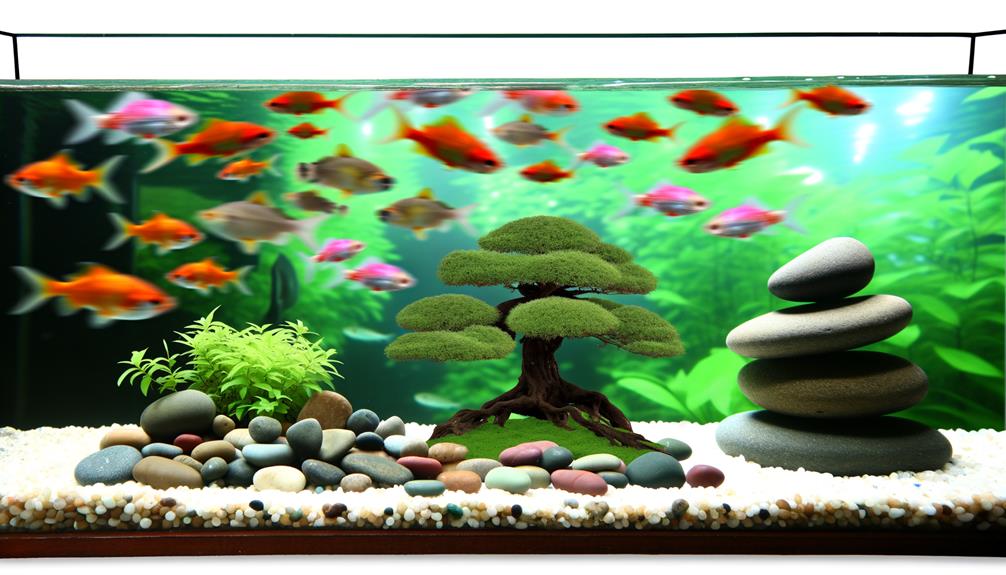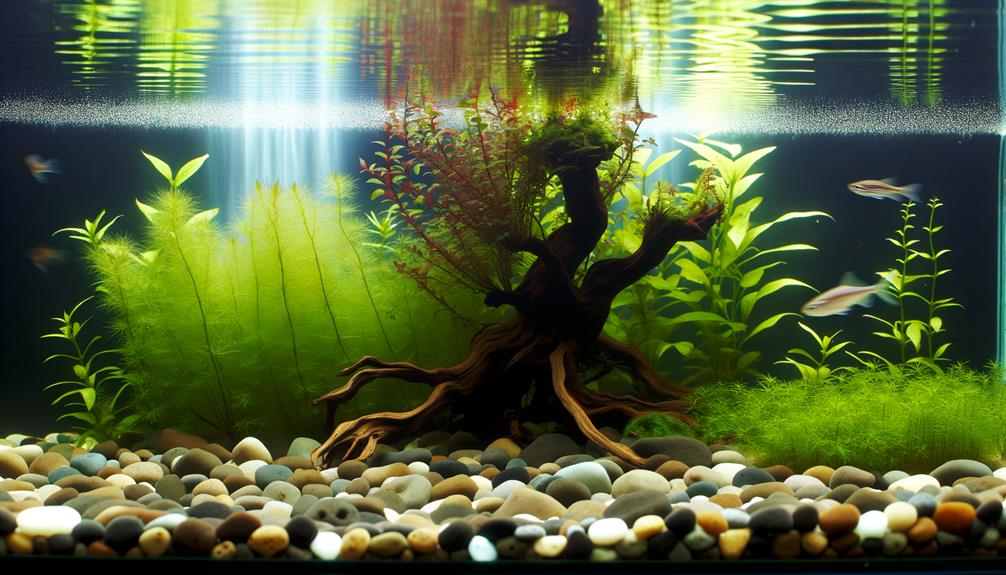How You Can Safely Put a Bonsai Tree in Your Aquarium
Yes, you can integrate a bonsai tree into an aquarium, but it requires careful planning and maintenance. Selecting species that tolerate high humidity and partial submersion, such as Ficus benjamina and Elms, is vital.
Proper lighting, CO2 levels, and nutrient availability must be balanced to secure the bonsai and aquatic life thrive symbiotically. Regular water quality monitoring, pruning, and the use of suitable substrates are essential for the bonsai's health.
Challenges include preventing algae growth and ensuring compatible tank mates. Mastering these elements can transform your aquarium into a vibrant aquatic ecosystem.
Explore further to enhance your setup.

Key Takeaways
- Certain bonsai species like Ficus and Elms can tolerate high humidity and partial submersion in aquariums.
- Proper tank size, water quality, and suitable substrate are essential for bonsai health in an aquarium.
- Regular pruning, shaping, and nutrient supplementation are necessary to maintain bonsai vitality underwater.
- Consistent monitoring of water parameters like pH, ammonia, and nitrates is crucial for a thriving bonsai.
- Appropriate LED lighting and aquarium-specific fertilizers support bonsai growth and prevent algae issues.
Feasibility of Combining Bonsai and Aquarium

Integrating a bonsai tree into an aquarium, often referred to as an 'aquascape,' necessitates a thorough understanding of both horticultural and aquatic principles to guarantee the viability of both the plant and the aquatic ecosystem. The primary challenge lies in ensuring that the bonsai tree, typically a terrestrial plant, can adapt to the aquatic environment. This involves careful selection of tree species, substrate, and water parameters to prevent root rot and other issues.
Additionally, the symbiotic relationship between the bonsai and aquatic flora and fauna must be balanced. Consideration must be given to factors such as light intensity, CO₂ levels, and nutrient availability. A successful aquascape requires meticulous planning and ongoing maintenance to harmonize the distinct needs of both domains.
Selecting the Right Bonsai
Selecting the right bonsai species for an aquarium setting is crucial, as it requires a plant that can tolerate high humidity and partial submersion without succumbing to root rot or other aquatic stressors. Species such as Ficus, especially Ficus benjamina and Ficus microcarpa, are well-suited due to their robust adaptability to moisture-laden environments.
Similarly, certain species of Elms (Ulmus) and Junipers (Juniperus) exhibit resilience under wet conditions. The critical aspect is ensuring that the bonsai's root system is capable of withstanding prolonged exposure to water without deteriorating. Moreover, the selected species must maintain structural integrity and growth patterns conducive to the confined space of an aquarium.
Proper selection guarantees the bonsai thrives, contributing to the aesthetic appeal and ecological balance of the aquarium.
Preparing the Bonsai Tree

To effectively prepare a bonsai tree for an aquarium, selecting a suitable species that can withstand submerged conditions is essential.
Detailed pruning and shaping techniques must be employed to guarantee the bonsai maintains its aesthetic appeal while adapting to the aquatic environment.
These preparatory steps are vital for fostering a healthy integration of the bonsai into an underwater ecosystem.
Selecting Suitable Bonsai Species
Selecting the appropriate bonsai species for an aquarium environment involves an understanding of both the tree's biological needs and the unique conditions within an aquatic setting. Suitable species typically include those that can withstand high humidity and partial submersion, such as Ficus and specific types of moss. These species are resistant to the constant moisture and reduced light levels commonly found in aquariums.
Additionally, the root system should be strong enough to anchor the tree securely under water while preserving its health. It is essential to avoid species that are highly sensitive to fluctuating water parameters or require extensive root aeration, as these conditions are difficult to maintain in an aquatic environment.
Choosing the right species ensures both visual appeal and longevity.
Pruning and Shaping Techniques
Mastering the art of pruning and shaping is crucial for preparing a bonsai tree to flourish aesthetically and biologically in an aquarium environment. Pruning involves strategically removing branches, leaves, and roots to control the tree's growth pattern, guaranteeing it remains small and manageable. This process enhances light penetration and water circulation, essential for a submerged bonsai.
Shaping, on the other hand, employs wiring techniques to guide branch direction and form, creating a visually appealing structure. Careful attention must be paid to the species-specific growth habits and the delicate balance between aesthetic appeal and biological health.
Regular maintenance, including trimming and re-wiring, ensures that the bonsai maintains its desired shape and thrives in the unique conditions of an aquarium.
Setting Up the Aquarium
Properly setting up the aquarium is an essential step that involves selecting an appropriate tank size, establishing a stable environment, and ensuring ideal water conditions for both the bonsai tree and aquatic life. This process demands meticulous attention to detail, including:
- Tank Size: Choose a tank that allows sufficient space for the bonsai tree and fish to coexist.
- Water Quality: Maintain appropriate pH, temperature, and nutrient levels to support both plant and animal health.
- Filtration System: Install an efficient filtration system to keep the water clean and oxygenated.
- Substrate: Use a suitable substrate to anchor the bonsai tree and support root growth.
- Lighting: Provide adequate lighting that mimics natural sunlight, essential for photosynthesis and overall well-being.
These elements are vital for creating a harmonious aquatic ecosystem.
Maintenance and Care Tips

Ensuring best water quality is paramount for the health of a bonsai tree housed in an aquarium, necessitating regular monitoring of parameters such as pH, ammonia, and nitrate levels.
Pruning and shaping the bonsai are important for maintaining its aesthetic form and promoting robust growth, requiring precision and regular attention.
Additionally, adequate light exposure and appropriate nutrient supplementation are necessary to sustain the tree's metabolic processes and overall well-being.
Water Quality Requirements
Maintaining best water quality is crucial for the health of both the bonsai tree and the aquatic life within the aquarium, necessitating regular monitoring of parameters such as pH, ammonia, nitrite, and nitrate levels. Consistent water testing guarantees a balanced environment, preventing toxic build-ups that could harm both flora and fauna.
Excellent water quality requires:
- pH levels: Maintain between 6.5 and 7.5 for most species.
- Ammonia: Should be undetectable; high levels are toxic.
- Nitrites: Also undetectable; harmful to aquatic life.
- Nitrates: Keep below 20 ppm to prevent algae growth.
- Water changes: Perform 10-20% weekly to dilute potential toxins.
Adhering to these parameters fosters a thriving ecosystem, supporting both the aesthetic and biological integrity of the aquarium.
Pruning and Shaping
To complement excellent water quality, regular trimming and shaping are necessary for maintaining the health and aesthetic appeal of a bonsai tree within an aquarium. Trimming involves the careful removal of overgrown or dead branches to promote new growth and maintain the desired shape. Utilizing sterilized trimming shears helps prevent infections.
Shaping, on the other hand, is achieved through strategic cutting and wiring. Wiring involves wrapping flexible wire around branches to guide their growth direction, achieving a balanced and visually pleasing form. Regular monitoring is vital as submerged bonsai trees can grow rapidly, necessitating frequent adjustments.
This meticulous care guarantees the bonsai tree remains a harmonious and thriving element within the aquatic environment.
Light and Nutrition
Proper light exposure and balanced nutrition are critical factors in sustaining the health and vibrancy of a bonsai tree within an aquatic environment. Addressing these needs can be challenging but is essential for best growth.
Light should replicate natural sunlight, typically requiring full-spectrum LED lighting for 8-12 hours daily.
Nutritional needs must be addressed through carefully balanced fertilization, avoiding excesses that may harm the aquatic ecosystem.
- Full-spectrum LED lighting: Replicates natural sunlight, essential for photosynthesis.
- Consistent photoperiod: 8-12 hours of light per day to maintain growth cycles.
- Balanced fertilization: Use aquarium-specific fertilizers to avoid toxicity.
- Nutrient monitoring: Regularly test water for nutrient levels.
- Avoiding over-fertilization: Prevents algae growth and maintains water quality.
Meeting these requirements ensures a thriving bonsai in an aquarium setting.
Common Challenges and Solutions
Integrating a bonsai tree into an aquarium presents a unique set of challenges, chiefly involving the maintenance of water quality, light conditions, and compatibility with aquatic life. Ensuring the bonsai tree does not decompose and affect water chemistry is critical. Proper light spectrum and intensity are necessary for both the bonsai and aquatic plants.
| Challenge | Solution |
|---|---|
| Water Quality | Regular monitoring and use of water conditioners |
| Light Conditions | Employing suitable LED lighting with timers |
| Algae Growth | Introducing algae-eating species |
| Root Maintenance | Regular pruning and trimming |
| Compatibility with Fish | Selecting compatible fish and plant species |
Addressing these challenges systematically can create a balanced and aesthetically pleasing aquascape, fostering a thriving environment for both flora and fauna.
Conclusion
Just as the harmonious coexistence of diverse species within an ecosystem exemplifies nature's balance, the integration of a bonsai tree within an aquarium symbolizes the delicate equilibrium between flora and aquatic environments.
Success in this endeavor demands meticulous selection, preparation, and maintenance, akin to a symbiotic relationship requiring mutual support.
Through scientific precision and care, one can achieve a microcosm of tranquility, where terrestrial and aquatic elements coexist in a seamless, interdependent dance of life.






